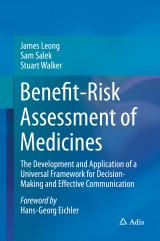Details

Benefit-Risk Assessment of Medicines
The Development and Application of a Universal Framework for Decision-Making and Effective Communication|
53,49 € |
|
| Verlag: | Adis |
| Format: | |
| Veröffentl.: | 21.04.2015 |
| ISBN/EAN: | 9783319158051 |
| Sprache: | englisch |
Dieses eBook enthält ein Wasserzeichen.
Beschreibungen
<p>This book proposes and investigates a universal framework, and accompanying documentation system, to facilitate and catalogue benefit-risk decisions; a valuable addition to the benefit-risk toolbox.</p><p>Over the past decade, pharmaceutical companies and regulatory agencies have been reviewing the benefit-risk assessment of medicines with a view to developing a structured, systematic, standardized approach. Examining the evaluation of such an approach by several mature regulatory authorities ensures that the reader gains a unique insight into the ongoing debate in this area.</p>The field of benefit-risk assessment continues to evolve at a rapid pace due to political and societal pressure, as is reflected in the recent FDA PUDFA agreement as well as in the EMA 2015 Roadmap. Rather than provide a comprehensive snap-shot of this constantly changing environment, this book evaluates selected current approaches to benefit-risk assessment. The strengths and weaknesses of publicly available documents in communicating benefit-risk decisions to stakeholders are reviewed and these evaluations are used to inform development of a prospective framework that could be used to harmonise procedures globally.
<p>Prologue.- Preface.- Overview.- Approaches to utilising decision-making framework.- Benefit-risk assessment of medicines by pharmaceutical companies and regulatory authorities.- Development of a universal benefit-risk framework and template.- Implementation of the benefit-risk assessment template by mature agencies.- Implementation of the benefit- risk summary template by a maturing agency: A case study.- Communicating benefit-risk decisions by US FDA, EMA, TGA and Health Canada.- Conclusions and future directions.- References.</p>
<p><b>James Leong, BSc Pharm Hons, MClinPharm, PhD, BCPS</b> is a Board certified pharmacist and Head of Education at the Centre of Regulatory Excellence, Duke-NUS Graduate Medical School Singapore. His role focuses on identifying the educational needs for the various stakeholders involved in regulatory affairs in the Asia Pacific region and establishing educational roadmaps, priorities and deliverables. He received his PhD in regulatory sciences from Cardiff University, UK.</p><p><b>Sam Salek PhD RPh FFPM MRPSGB MCMS FESCP </b>is Professor of Pharmacoepidemiology at the University of Hertfordshire, Hatfield, visiting Professor at the Estate of Hessen, Germany, and Director of the Institute for Medicines Development, Cardiff, UK. Professor Salek’s research focuses on mainly four areas including: development and application of patient-reported outcome measures; drug safety evaluation and pharmacovigilance; pharmacoeconomics and economic evaluation of healthcare; and pharmaceutical regulation and medicines development in the mature and emerging markets. He has published 19 books and 600 journal articles and abstracts. Professor Salek is member of five Editorial Boards and an active member of several societies.</p><p><b>Stuart Walker</b> <b>BSc, PhD, MFPM FRSC FIBiol, FRCPath</b>, is the Founder of the Centre for Medicines Research International, the Centre for Innovation in Regulatory Science and Professor of Pharmaceutical Medicine, University of Wales, Cardiff. During his research career in academia and industry, he has supervised many PhD programmes in clinical development, regulatory policies, the Benefit/Risk Assessment of Medicines and Health Technology Assessment, co-authored 280 research papers and edited twenty-five books. He is frequently involved in the organisation of international meetings on key issues that concern the Regulatory Review of Medicines and has lectured extensively throughout Europe, the United States, the Asia-Pacific Region, LatinAmerica and the Middle East.</p>
<p>This book proposes and investigates a universal framework, and accompanying documentation system, to facilitate and catalogue benefit-risk decisions; a valuable addition to the benefit-risk toolbox. </p><p>Over the past decade, pharmaceutical companies and regulatory agencies have been reviewing the benefit-risk assessment of medicines with a view to developing a structured, systematic, standardized approach. Examining the evaluation of such an approach by several mature regulatory authorities ensures that the reader gains a unique insight into the ongoing debate in this area.</p><p>The field of benefit-risk assessment continues to evolve at a rapid pace due to political and societal pressure, as is reflected in the recent FDA PUDFA agreement as well as in the EMA 2015 Roadmap. Rather than provide a comprehensive snap-shot of this constantly changing environment, this book evaluates selected current approaches to benefit-risk assessment. The strengths and weaknesses of publicly available documents in communicating benefit-risk decisions to stakeholders are reviewed, and these evaluations are used to inform development of a prospective framework that could be used to harmonise procedures globally.</p>
Examines current approaches for the benefit-risk assessment of medicines and the acceptability of a “universal framework” by regulatory agencies and pharmaceutical companies Presents the development and implementation of a template for documenting benefit-risk decisions in a structured systematic transparent manner Reviews the strategies of major regulatory authorities (US FDA, EMA, Australia and Health Canada) for communicating benefit-risk decisions to stakeholders and how they can be improved using the newly developed B-R template
Diese Produkte könnten Sie auch interessieren:

Apoptotic Pathways as Targets for Novel Therapies in Cancer and Other Diseases

von: Marek Los, Spencer B. Gibson

149,79 €















